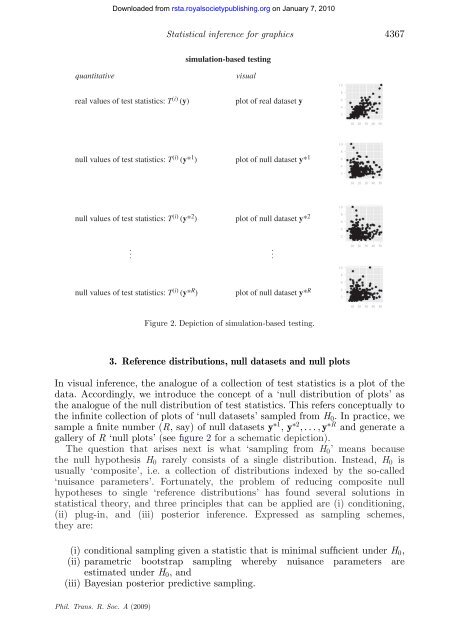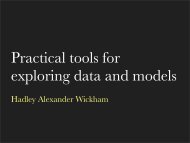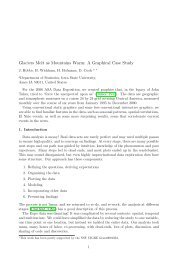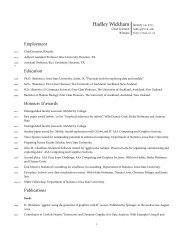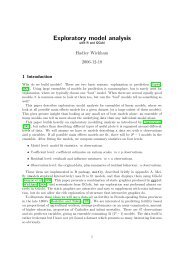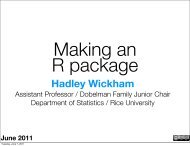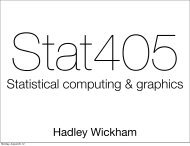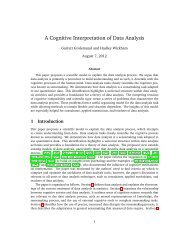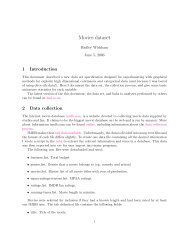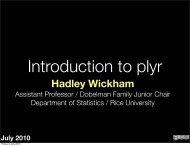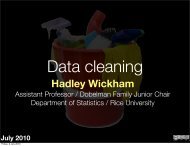Statistical inference for exploratory data analysis ... - Hadley Wickham
Statistical inference for exploratory data analysis ... - Hadley Wickham
Statistical inference for exploratory data analysis ... - Hadley Wickham
Create successful ePaper yourself
Turn your PDF publications into a flip-book with our unique Google optimized e-Paper software.
<strong>Statistical</strong> <strong>inference</strong> <strong>for</strong> graphics 4367<br />
simulation-based testing<br />
quantitative visual<br />
real values of test statistics: T (i) (y)<br />
null values of test statistics: T (i) (y* 1 )<br />
null values of test statistics: T (i) (y* 2 )<br />
null values of test statistics: T (i) (y* R )<br />
plot of real <strong>data</strong>set y<br />
plot of null <strong>data</strong>set y* 1<br />
plot of null <strong>data</strong>set y* 2<br />
plot of null <strong>data</strong>set y* R<br />
Figure 2. Depiction of simulation-based testing.<br />
3. Reference distributions, null <strong>data</strong>sets and null plots<br />
10<br />
8<br />
6<br />
4<br />
2<br />
10<br />
8<br />
6<br />
4<br />
2<br />
10<br />
8<br />
6<br />
4<br />
2<br />
10<br />
8<br />
6<br />
4<br />
2<br />
10 20 30 40 50<br />
10 20 30 40 50<br />
10 20 30 40 50<br />
10 20 30 40 50<br />
In visual <strong>inference</strong>, the analogue of a collection of test statistics is a plot of the<br />
<strong>data</strong>. Accordingly, we introduce the concept of a ‘null distribution of plots’ as<br />
the analogue of the null distribution of test statistics. This refers conceptually to<br />
the infinite collection of plots of ‘null <strong>data</strong>sets’ sampled from H0. In practice, we<br />
sample a finite number (R, say) of null <strong>data</strong>sets y ∗1 , y ∗2 , ..., y ∗R and generate a<br />
gallery of R ‘null plots’ (see figure 2 <strong>for</strong> a schematic depiction).<br />
The question that arises next is what ‘sampling from H0’ means because<br />
the null hypothesis H0 rarely consists of a single distribution. Instead, H0 is<br />
usually ‘composite’, i.e. a collection of distributions indexed by the so-called<br />
‘nuisance parameters’. Fortunately, the problem of reducing composite null<br />
hypotheses to single ‘reference distributions’ has found several solutions in<br />
statistical theory, and three principles that can be applied are (i) conditioning,<br />
(ii) plug-in, and (iii) posterior <strong>inference</strong>. Expressed as sampling schemes,<br />
they are:<br />
(i) conditional sampling given a statistic that is minimal sufficient under H0,<br />
(ii) parametric bootstrap sampling whereby nuisance parameters are<br />
estimated under H0, and<br />
(iii) Bayesian posterior predictive sampling.<br />
Phil. Trans. R. Soc. A (2009)<br />
Downloaded from<br />
rsta.royalsocietypublishing.org on January 7, 2010


